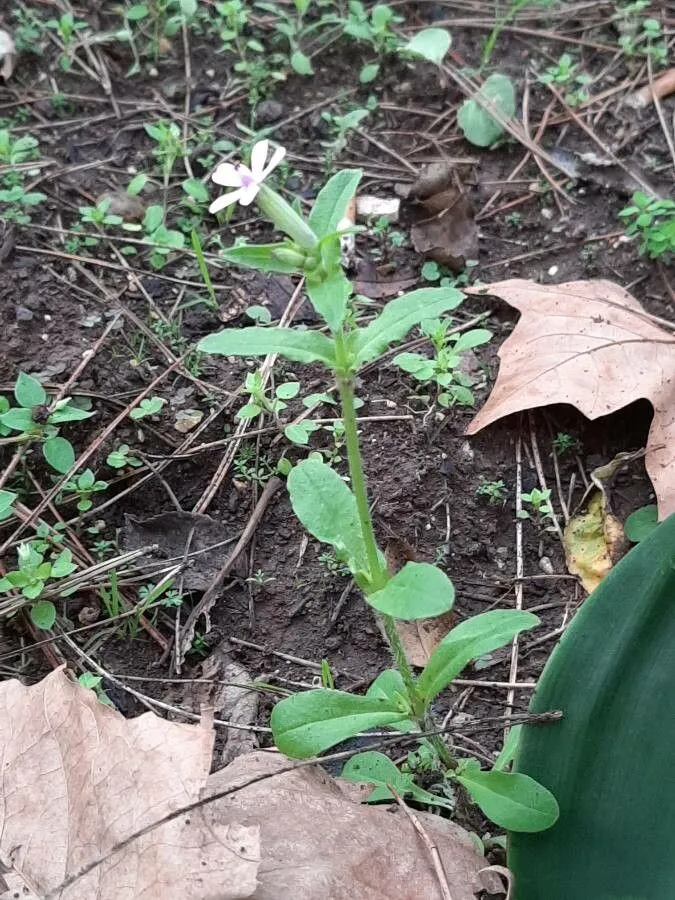
Author: L.
Bibliography: Sp. Pl.: 409 (1753)
Year: 1753
Status: accepted
Rank: species
Genus: Saponaria
Vegetable: False
Observations: SW. & SC. Europe
Rock soapwort, known scientifically as Saponaria ocymoides, is a charming and versatile perennial herbaceous plant renowned for its vibrant pink flowers and low-growing, spreading habit. First described in 1753 by the esteemed botanist Carl Linnaeus in his seminal work “Species Plantarum,” this plant has captured the interest of gardeners and botanists alike for centuries.
Native to the regions of Southwestern and South-Central Europe, rock soapwort thrives in rocky, well-drained soils where it often adorns alpine slopes and gravelly meadows. Belonging to the Caryophyllaceae family, which includes a variety of other ornamental and medicinal plants, it shares many characteristics typical of this group, such as its opposite leaves and five-petaled flowers.
One of the most striking features of rock soapwort is its profusion of small, star-shaped flowers that bloom from late spring to early summer. The flowers typically exhibit a soft pink hue, although they can range from pale pink to deep magenta, creating a stunning carpet of color that can transform rock gardens, edges, and slopes into a vibrant tapestry.
Gardening enthusiasts appreciate Saponaria ocymoides not only for its aesthetic appeal but also for its hardy nature and ease of cultivation. The plant prefers full sun to partial shade and can tolerate a variety of soil types, provided they are well-draining. Its low-growing and spreading form makes it an excellent choice for ground cover, helping to prevent soil erosion and suppress weed growth.
Moreover, rock soapwort has a historical use as a cleaning agent. The name “soapwort” derives from its sap, which contains saponins and was traditionally used to create a mild lather for cleaning purposes. While no longer a common practice, this interesting aspect adds to the plant’s rich historical and botanical heritage.
In summary, rock soapwort (Saponaria ocymoides) is a delightful addition to gardens, particularly valued for its beautiful pink blooms and its contribution to soil conservation. Its historical significance and ease of growth make it a beloved choice for both novice and experienced gardeners. By incorporating such a resilient and attractive plant into garden settings, one can enjoy both its beauty and its practical benefits throughout the growing season.
Deu: kleines seifenkraut, rotes seifenkraut
Dan: lav sæbeurt
Eng: rock soapwort, tumbling-ted
Swe: liten såpnejlika
Ces: mydlice bazalkovitá
Fra: saponaire faux-basilic, saponaire rose
Nld: muurzeepkruid
Cym: sebonllys y graig
En: Rock soapwort, Tumbling-Ted, Tumbling Ted
Ca: Falsa alfàbrega, Saponària petita
Zh: 罗勒石碱花
Cs: Mydlice bazalkovitá
Da: Lav sæbeurt
Nl: Muurzeepkruid, Rotszeepkruid
Fi: Kivikkosuopayrtti
Fr: Saponaire faux-basilic, Saponaire de Montpellier, Saponaire rose, Saponaire des rochers, Saponaire faux basilic
De: Kleines Seifenkraut, Rotes Seifenkraut
Hu: Gyepes szappanfű
It: Saponaria rossa
Pl: Mydlnica bazyliowata
Sk: Mydlica bazalkovitá
Sv: Liten såpnejlika
Zh-tw: 羅勒石碱花
Cy: Sebonllys y graig
© copyright of the Board of Trustees of the Royal Botanic Gardens, Kew.
© copyright of the Board of Trustees of the Royal Botanic Gardens, Kew.
© copyright of the Board of Trustees of the Royal Botanic Gardens, Kew.
Taken May 14, 2017 by fossas russell (cc-by-sa)
Taken Jun 16, 2018 by Núria Comas (cc-by-sa)
Taken Mar 13, 2018 by jose (cc-by-sa)
Taken Mar 13, 2018 by jose (cc-by-sa)
Taken May 31, 2020 by yann claret (cc-by-sa)
Taken Jun 18, 2021 by Ann De Blick (cc-by-sa)
Taken Jun 12, 2020 by Roberto Dessì (cc-by-sa)
Taken May 17, 2021 by Jean-François Baudin (cc-by-sa)
Taken Dec 23, 2021 by Monteiro Henrique (cc-by-sa)
Taken Jan 25, 2022 by Geammi Esmarti Saldaña Vallejos (cc-by-sa)
Taken Sep 23, 2020 by Eska (cc-by-sa)
Taken Jun 5, 2022 by Monique RAUGI (cc-by-sa)
Taken Jun 18, 2021 by Manuëlle (cc-by-sa)
Taken Jun 12, 2020 by Roberto Dessì (cc-by-sa)
Taken Dec 23, 2021 by Monteiro Henrique (cc-by-sa)
Taken May 31, 2021 by Queralt Jordi (cc-by-sa)
Taken Apr 27, 2012 by Tela Botanica − Yoan MARTIN (cc-by-sa)
Taken May 11, 2019 by Llandrich anna (cc-by-sa)
Taken Apr 15, 2021 by Llandrich anna (cc-by-sa)
Taken May 27, 2016 by Martin Bishop (cc-by-sa)
Taken Mar 29, 2021 by Jacques Zuber (cc-by-sa)
Taken Aug 19, 2021 by Pietro Brignoli (cc-by-sa)
Taken May 13, 2021 by Fabien Onfroy (cc-by-sa)
Taken May 11, 2019 by Llandrich anna (cc-by-sa)
Taken Apr 15, 2021 by Llandrich anna (cc-by-sa)
Taken Jun 11, 2019 by K Max (cc-by-sa)
Taken Sep 8, 2019 by Serge Ottaviani (cc-by-sa)
Taken Jun 16, 2021 by Franz Steffen (cc-by-sa)
Taken Jun 9, 2021 by Jacques Zuber (cc-by-sa)
Taken Jul 17, 2011 by Tela Botanica − Yoan MARTIN (cc-by-sa)
Growth habit: Forb/herb
Bloom months: [‘may’, ‘jun’, ‘jul’]
Family: Myrtaceae Author: (F.Muell.) K.D.Hill & L.A.S.Johnson Bibliography: Telopea 6: 402 (1995) Year: 1995 Status:…
Family: Rubiaceae Author: Pierre ex A.Froehner Bibliography: Notizbl. Bot. Gart. Berlin-Dahlem 1: 237 (1897) Year:…
Family: Sapindaceae Author: Koidz. Bibliography: J. Coll. Sci. Imp. Univ. Tokyo 32(1): 38 (1911) Year:…
Family: Asteraceae Author: A.Gray Bibliography: Pacif. Railr. Rep.: 107 (1857) Year: 1857 Status: accepted Rank:…
Family: Fabaceae Author: Medik. Bibliography: Vorles. Churpfälz. Phys.-Ökon. Ges. 2: 398 (1787) Year: 1787 Status:…
Family: Aspleniaceae Author: (Cav.) Alston Bibliography: Bull. Misc. Inform. Kew 1932: 309 (1932) Year: 1932…